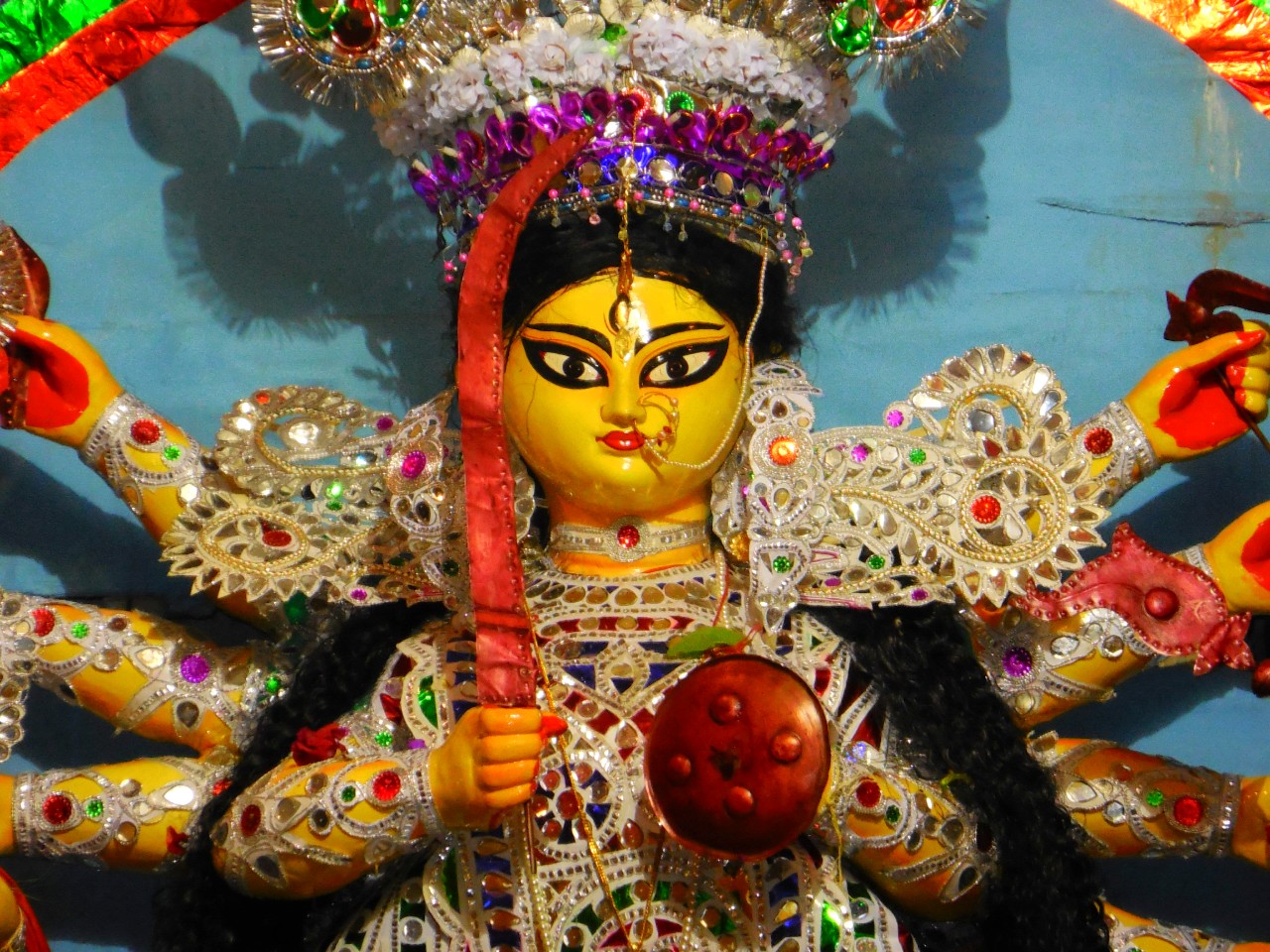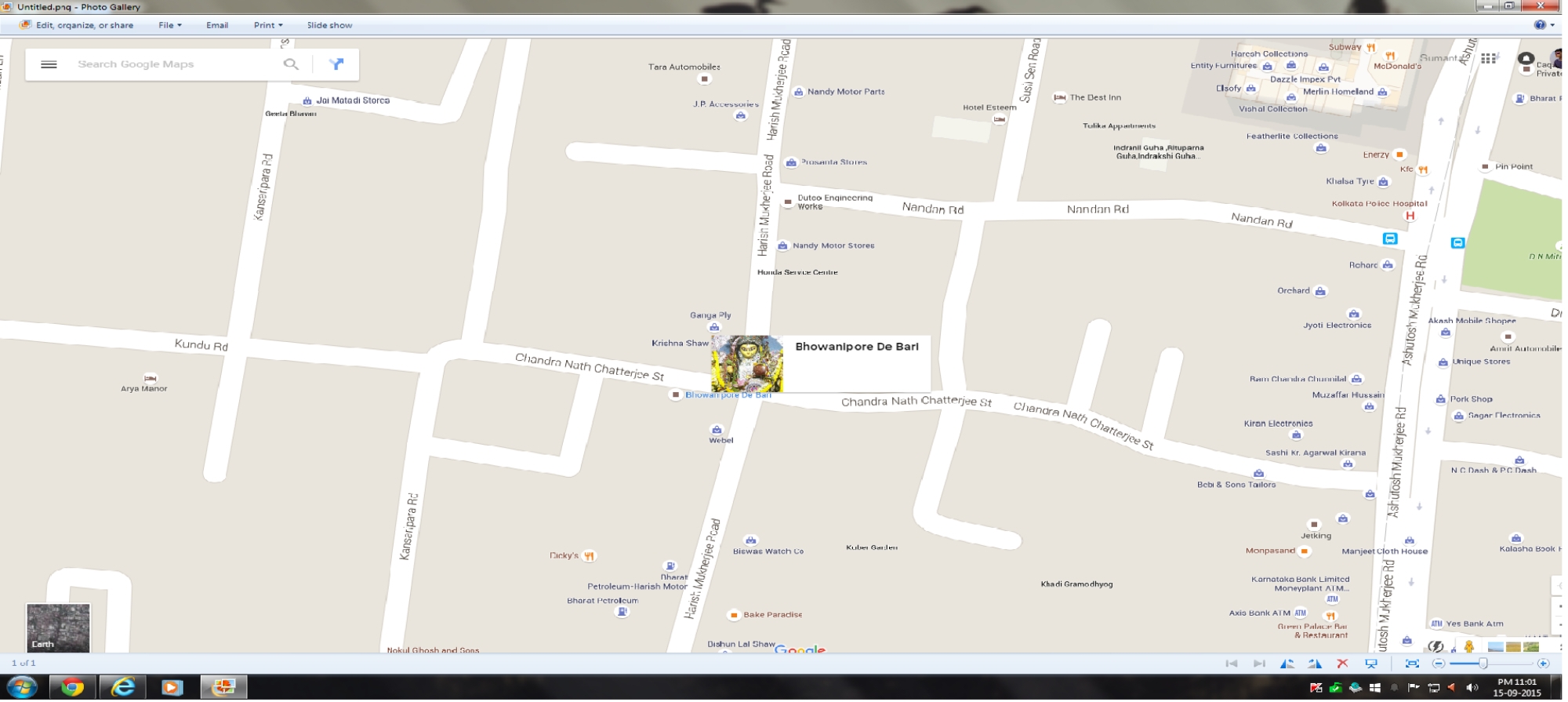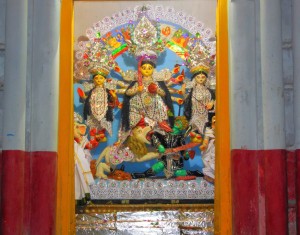Bhowanipore De bari
Bhowanipore De bari
Bhowanipore De bari
[wpi_designer_button text=’Bhowanipore De bari’ link=’De bari‘ style_id=” target=’self’]
Started In – 1870 A.D.
Address: 26/E, Chandra Nath Chatterjee Street, Bhowanipore, Kolkata – 700025
1st Potter – Mr. Rabin Paul
Present Potter – Mr. Ajay Paul
Present Priest – Mr. Swapan Bhattacharya
Electrician – Mr. Anupom Mondal
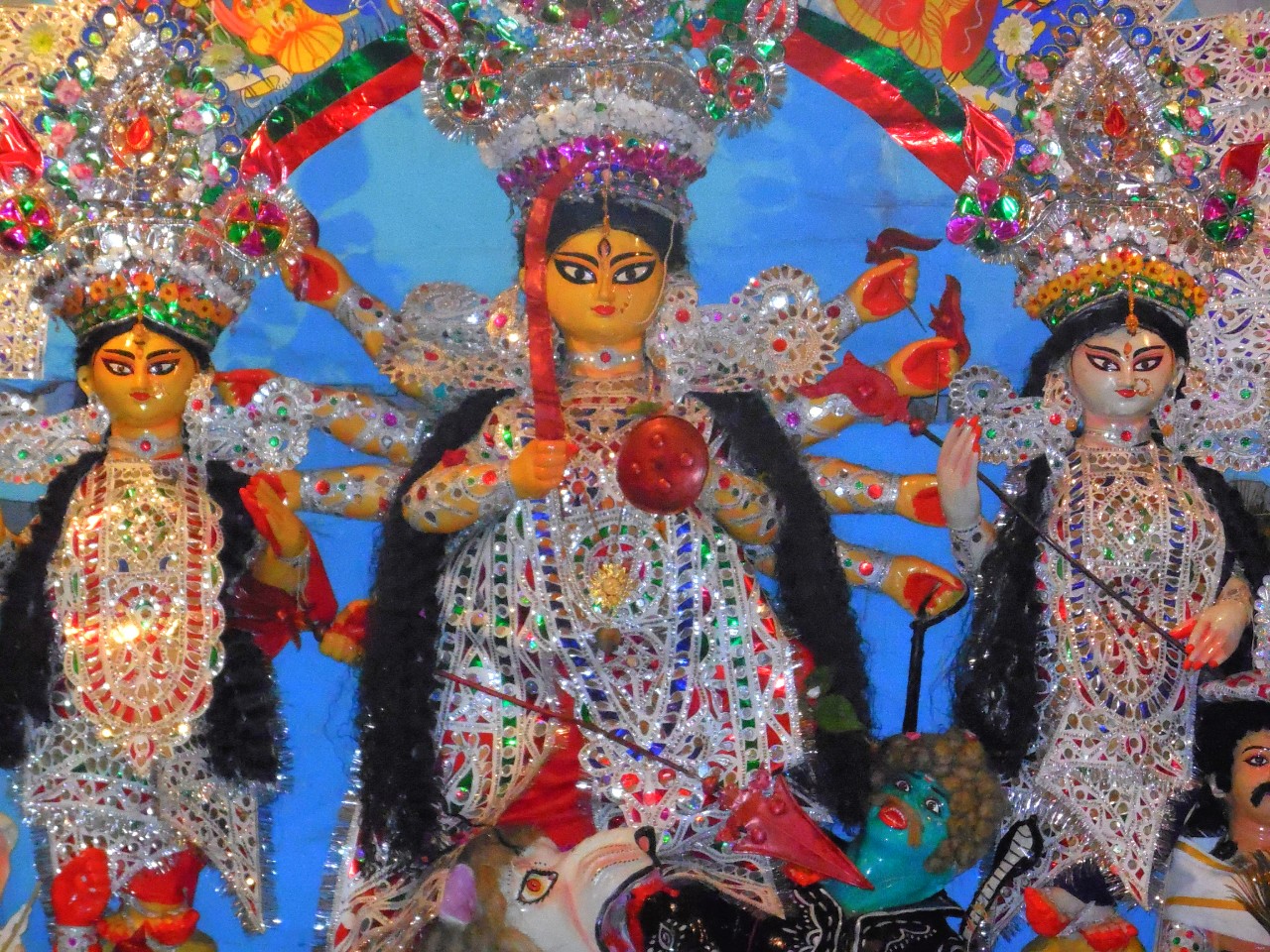
Durga Puja is celebrated during six days in a year which is observed as Mahalaya, Sasthi, Maha Saptami, Maha Ashtami, Maha Nabami and Vijayadashami. The dates of Durga Puja celebrations are set according to the traditional Hindu calendar and the fortnight corresponding to the festival is called Devi Paksha, “Fortnight of the Goddess”). Devi Paksha is preceded by Mahalaya, the last day of the previous fortnight Pitri Paksha, “Fortnight of the Forefathers”), and is ended on Kojagori Lokkhi Puja (“Worship of Goddess Lakshmi on Kojagori Full Moon Night”).
While the rituals entails ten days of fast, feast and worship, the last four days – Saptami, Ashtami, Navami and Dashami – are celebrated with much gaiety and grandeur in India and abroad, especially in Bengal, where the ten-armed goddess riding the lion is worshipped with great passion and devotion. The preparation of this Durga Puja started from the very 3months before actual puja is going to start.
It is known that our puja was started on account of a “Swapnadesh” (order through Dream) given to Late RAMLAL DE, the head of our Family during that regime.
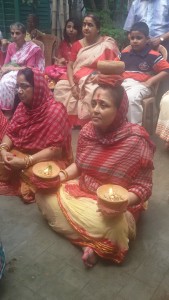
Family Background – Ramlal De was born in the year 1846 in a place called ‘Gobor-danga’ located in the city of Calcutta. He started the Durga Puja of our family in the year 1870. His 3 sons were Atul Krishna De, Anukul Krishna De & Radha Kanta De. Among them Atul Krishna De & Anukul Krishna De started business of Cotton, bed-sheets and pillow in that era. This tradition is still followed in our family by their descendants.
One day he saw that a mother with her 2 daughters & 2 sons were waiting in-front of our main door. When he asked her whom she wants to meet, then the mother with her sons & daughters enters into our house without answering the question and disappeared. No one could find her in our house. Also one day Goddess Durga came in the dreams of Ramlal De and orders him to worship her in our house. This was the occasion of starting of Durga Puja in our ‘De Family’. Currently puja is being carried on by Sri Khangendra Nath De (grandson of Ramlal De) and other subordinate members of our family.
Durga Puja festival marks the victory of Goddess Durga over the evil buffalo demon Mahishasura. Thus, Durga Puja festival epitomises the victory of Good over Evil. The prominence of Durga Puja increased gradually during the British Raj in Bengal. After the Hindu reformists identified Durga with India, she became an icon for the Indian independence movement.
On the day of ‘Rath-Yatra’ the frame of the idol (In Bengali- kathamo) is worshipped by our priest which represents the starting of making the idols. From the day of ‘Janmasthami’ the poter started making the idol at our own houses.
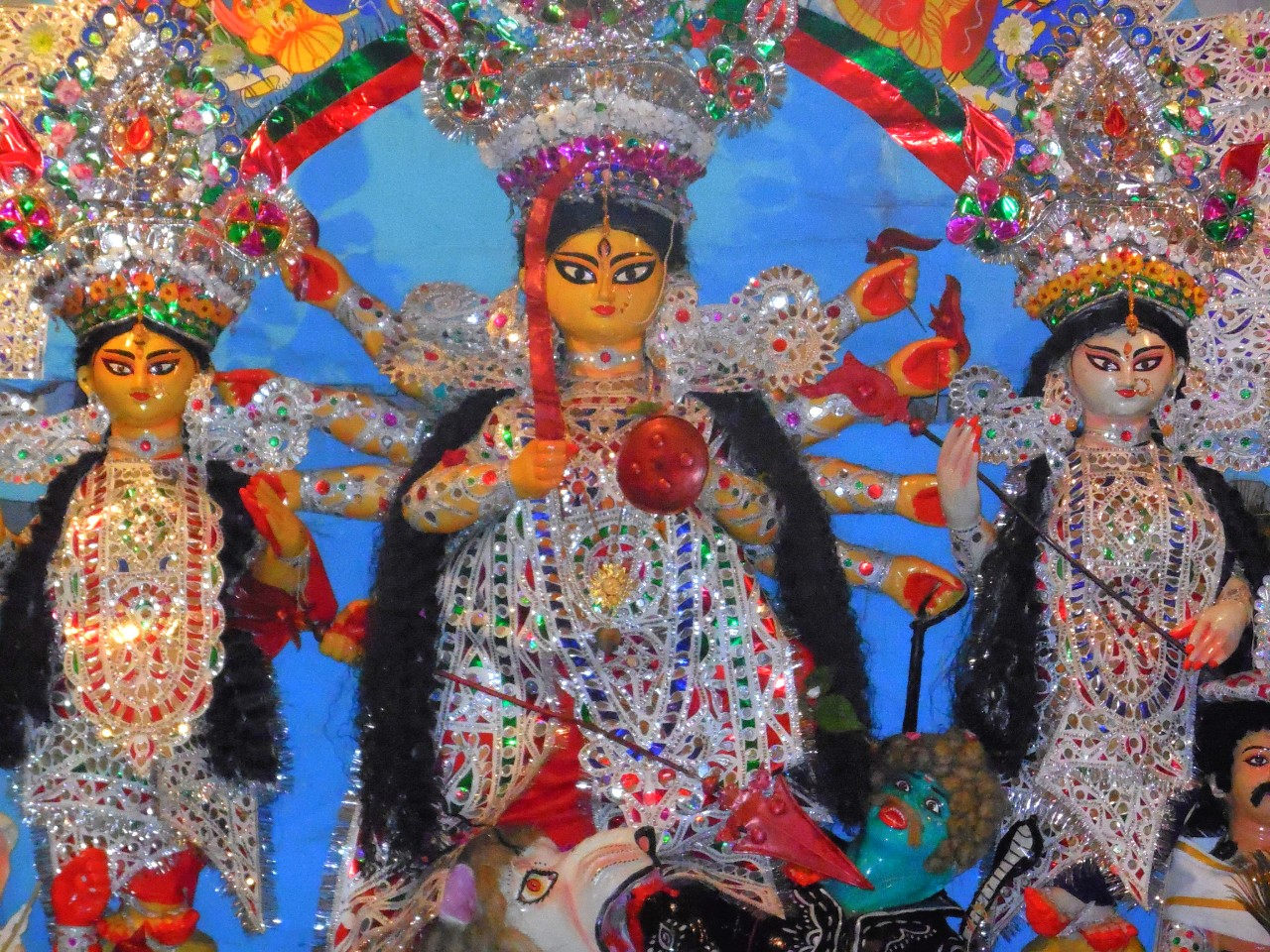
The idol of Mother Durga here is somewhat special and different. Traditional clay image of Durga pratima in our house is made of clay with all five gods and goddesses under one structure which is known as ‘ek-chala’ (‘ek’ = one, ‘chala’ = cover). Main important attraction of our idol is that Goddess Durga is seen here in the form of slayer of the British Raj. The evil buffalo demon symbolises the British Raj. The demon here wears Coat, Pant, Tie and Boot.
Here Lion painted all white with manes and moustache in brown. Ganesh and Kartick wears than, Dhuti and Chaddar made of Cotton. Lakshmi and Saraswati do not come with their Bahans (Carriers) but instead stands on Lotus Flowers.
After the decoration is completed by the Kumars (Artists), the Deities are further individually decorated with several Ornaments, Weapons, Instruments etc. meant and preserved for them by the Family. Here the deities are only decorated by the male members of our family starting from sarees to other ornaments (In Bengali – Saaj). No outsiders can get involved in this decoration. The weapons are covered with ‘Sidoor’ before putting them in the hands of the deities.
In olden days Puja used to start from Pratipad but at present from Panchami day. The Bodhon is held at Thakurghar, the Pratima Puja is celebrated at Puja Mandap. This grants access to Public to watch, Worship and offer Prayers.
On the eve of Sasthi, our priest worships the earthen pot which is placed in our “Bodhon-Ghar” (a specified room) which is believed as the place where goddess belongs to our house.
Next day, i.e. on Saptami morning Kalabou (wife of Sri Ganesh i.e. son of Maa Durga) is taken for holy bath in Ganges. After taking bath there the Kala-bou is returned back to our mandap and again bathed with various Ingredients, Perfumes etc. and Sacred Waters collected from various Rivers of India. After a Befitting Dress, Ornaments etc. she is attached to the Pratima, next to Ganesh for worshipping.
With start of Puja on Saptami morning, the Member of the Family in whose name Puja is conducted (Sankalpa) authorises Purohit to perform worshipping, on his behalf. He has to remain in fast for the whole day till end of Aarati in Evening and can take only Bhog offered to Deity. Like Kala-bou, Griha Lakshmi and Tulsi- tree are placed close to the Pratima for daily worshipping.
With the start of Puja a big Lamp is lit with Ghee made of Cow-Milk. This Lamp is kept non-stop burning till the end of Puja on Dasami. Being non-Brahmins, we don’t have the ritual of offering Annabhog in the Morning but instead a ‘Sital’ (which includes Luchi, Milk and Sweets) is offered in the Evenings on the Puja days. This ‘Sital’ is considered as the primary and main food offerings to the goddess.
Worshipping Kumari Puja and Sadhaba Puja on Astami are performed by the Women folks of the Family. Female members of our family are also engaged in a special type activity which is known as “Dhuno-Porano” where they sit in front of our goddess in wet saree and enlightened earthen pots were placed in their both hands and head. After that all members of our family treat them as a part of goddess durga and worship them.
Sandhi Puja is performed at the juncture of Astami and Navami, within limited period for 48 minutes. Various articles for use of Mother Durga, including Sari, Bangles, Perfumes, Utensils, Beddings Naibedya (with all kinds of Fruits and Sweets etc.) are offered on this occasion. A set of 108 Oil Lamps (in Earthen Pots) are lit at the time of this Puja. Also offering and worshiping with 108 Padma (Lotus) Flowers is a must. 21Kgs of rice are offered to the goddess in this Sandhi Puja with various other ingredients like – fruits, sweets, etc.
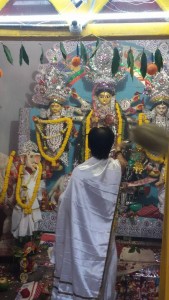
In Navami, 9 types of flower are offered to Maa Durga. Offering of 108 nos. of Billapatra absolutely clean, clear and spotless are made in Hom from at the Jogyakundu in this day. The log of Wood is kept burning during the specified period under vigilant watch.
In earlier days Buffaloes and Goats were slaughtered in front of Mother Durga in the Courtyard and offered to her as Puja. This process has been discarded with change of time. However this ritual continues with cutting of Akkh, Coconut and Chalkumra.
On Dasami with chanting of Mantras Aparajita Creeper is tied on the Hands of all Deities. On this day the Earthen Vessel is filled with Ganges Water mixed with Turmeric and placed in front of Pratima in such a position, it helps to reflect the Body of Mother Durga, from Face to Toe, to indicate the complete Immersion of the Image worshipped. Mantras specially meant for the occasion are chanted while this process of immersion continues. On evening of Dasami after different Rituals and Siddur Khela by the Women folks of the Family. Another special tradition of our family is the structure of the Pratima is carried to Ganges River for actual immersion by our family members and carriers on their shoulders with the help of bamboo pole. The Frame is taken back Home and kept reserved for use in subsequent years.
